Exploring the Height of Burj Khalifa: An In-Depth Analysis
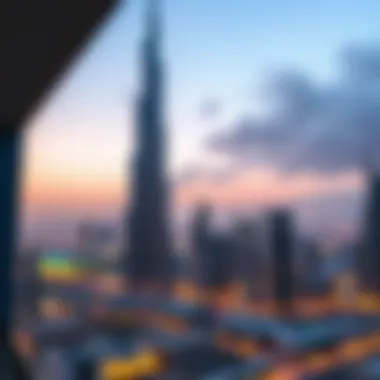
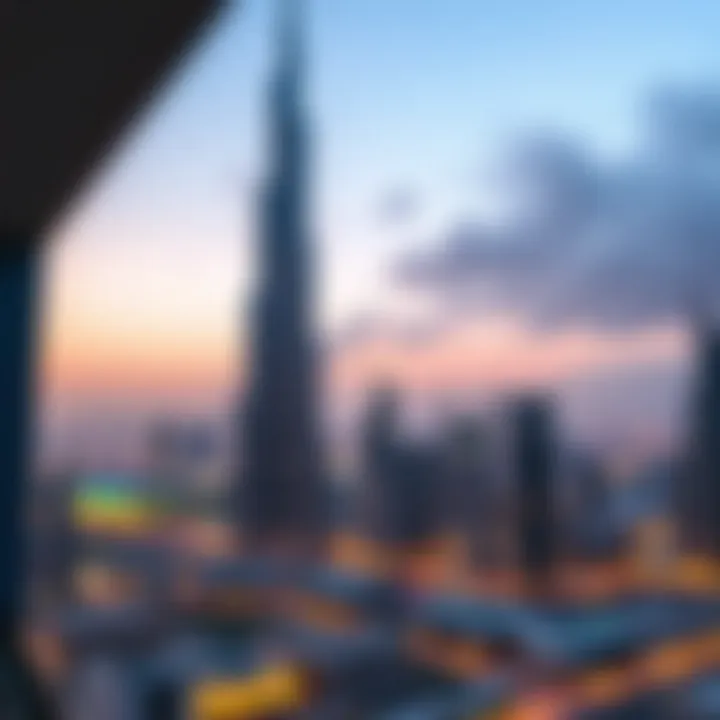
Intro
Burj Khalifa, standing tall at a staggering height of 828 meters, is not just an architectural feat but a modern emblem of ambition and innovation. Nestled in the heart of Dubai, this iconic structure has redefined city skylines and inspired awe across the globe. The building's colossal height is a testament to what is achievable when imagination blends seamlessly with cutting-edge engineering. In a world where urban landscapes are being rapidly transformed, Burj Khalifa emerges as a beacon, illuminating pathways for future projects and real estate developments.
As we peel back the layers that surround this towering giant, we find layers of complexity intertwined with its very essence. From its architectural design that merges aesthetics with functionality, to the construction techniques that were groundbreaking at the time, every aspect contributes to its status in the architectural hall of fame. But beyond the numbers and blueprints, Burj Khalifa holds significant sway over Dubai’s real estate market, influencing property values and attracting global investors.
At its core, this article aims to guide you through the heights of Burj Khalifa, exploring its impact on Dubai’s economic landscape and the opportunities it creates for those looking to invest in the region. Let’s embark on this exploration—one that will shed light on not just the structure itself, but the broader context in which it flourishes.
Market Insights
Current Trends in Dubai Real Estate
The real estate market in Dubai has experienced waves of change, with different phases reflecting the city’s growth and economic shifts. Nowadays, areas surrounding Burj Khalifa, including Dubai Downtown, have seen a surge in property values. Investors are keenly aware that proximity to such an iconic landmark can significantly boost the price of residential and commercial properties. This is particularly noticeable in projects like The Address Downtown, which draws a premium due to its close relationship with the tower.
However, as the market evolves, the trends are shifting. More buyers are seeking sustainable, energy-efficient homes. Thus, newer developments are incorporating green building standards to attract eco-conscious investors. This adjustment in buyer preferences is steering the design and construction of properties even further, ensuring that the skyline is not only a marvel of human ingenuity but also a step towards sustainability.
Analysis of Investment Opportunities
Investing in Dubai’s real estate offers numerous opportunities, particularly in areas influenced by Burj Khalifa’s prestige. Many investors are shifting their focus to off-plan developments that promise high returns. The potential for rental yield remains strong, especially in luxury apartments which witness a high demand from expatriates and tourists.
Moreover, the tourism sector tied to Burj Khalifa continues to flourish, presenting a promising landscape for short-term rental markets. Notably, occupancy rates in hotels and vacation rentals in Downtown Dubai stay above average, thanks to the steady flow of tourists eager to experience the view from the observation deck of Burj Khalifa.
One important consideration for investors includes careful analysis of market conditions and prices. The real estate landscape in Dubai can be complex, and prospective buyers should ensure they understand the dynamics at play. To navigate successfully, investment in market research and engaging local experts can make a significant difference.
"In the world of investment, opportunities can sometimes be as tall as the structures we aspire to build. Seize them while the momentum is high."
For comprehensive data and further reading on Dubai’s evolving real estate market, visit Wikipedia or Britannica.
Next, we will delve deeper into the specifics of the Burj Khalifa itself—its architectural nuances and the impact it holds over the Dubai community.
Height Specifications
Height specifications might seem like just numbers at first glance, but in the case of Burj Khalifa, they tell a story of ambition, innovation, and an evolving skyline. The sheer size of this iconic structure not only defines Dubai’s physical landscape but also reflects its cultural aspirations. The importance of discussing height specifications goes beyond the measurments; it emphasizes how they become symbols of national pride and global competition. In a world where cities vie to stand out, Burj Khalifa's height places it firmly in the spotlight, showcasing the engineering prowess and vision that defined its creation.
Official Height Measurement
The official height of Burj Khalifa is a stunning 828 meters, making it the tallest building on the planet. This figure isn't just a arbitrary number; it includes every inch of this architectural marvel, from the base to the tip of its spire, which is a significant element in defining its overall height. The building’s construction was completed in 2010 and was officially opened to the public soon after.
To give a bit of context, the height was meticulously calculated and verified by several organizations, including the Council on Tall Buildings and Urban Habitat. This measurement took into account not just the architectural height but also the total structural height, which is a standard that experts in the field are keen to uphold. Every detail, from the design's inherent aesthetics to the challenging engineering feats required to achieve this height, is worthy of recognition.
Height Comparisons
When people start comparing skyscrapers, things can get a bit dizzying. For instance, the second tallest building, Shanghai Tower, stands at 632 meters. That is a significant height, but it falls short of Burj Khalifa's remarkable reach. Here’s a look at some notable comparisons:
- Burj Khalifa: 828 meters
- Shanghai Tower: 632 meters
- Abraj Al Bait Towers (Mecca): 601 meters
- Ping An Finance Center (Shenzhen): 599 meters
While these structures are indeed impressive, they should be viewed in the context of what Burj Khalifa has accomplished. The leap from 632 meters (Shanghai Tower) to 828 meters is not just a question of numbers but one of engineering and design – an illustration of what can be accomplished when you push the limits of design and ambition.
"Height is not just a measurement; it is a declaration of what a city can aspire to be."
In essence, the comparisons serve to elevate Burj Khalifa beyond the confines of mere architectural statistics. They reveal the profound implications of the quest for height, in which Dubai has positioned itself as a leader. This height analysis fosters an understanding of Burj Khalifa's significance, putting into perspective how much cities are willing to invest in their identities on the global stage.
Architectural Significance
The architectural significance of Burj Khalifa extends far beyond its astonishing height. It stands as a testament to human ingenuity and ambition, redefining what is possible in modern construction. This section aims to explore the underlying principles and aesthetic values that contribute to the Burj Khalifa’s iconic status.
Design Vision
The design vision for Burj Khalifa was led by Adrian Smith of Skidmore, Owings & Merrill, who sought to create a structure that reflects the cultural identity of Dubai while pushing the limits of architectural design. Inspired by the Islamic architecture and the desert flower Hymenocallis, the building exhibits a series of setbacks, creating an upward spiraling form. This not only allows for impressive views but also reduces wind shear effect, which is crucial in high-rise buildings.
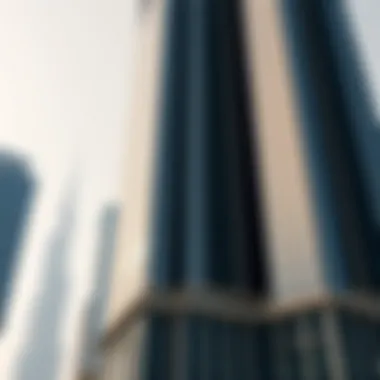
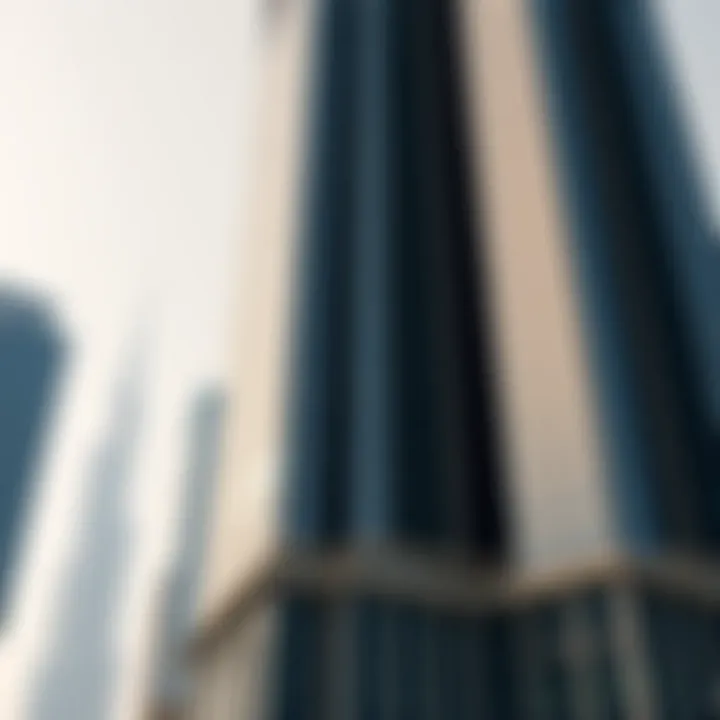
- Cultural Influence: The design embodies Islamic motifs yet remains distinctly modern. The building’s Y-shape stems from traditional Islamic architecture, symbolizing unity and harmony.
- Aesthetic Appeal: The sleek, glass-clad surface mirrors the surrounding skyline and desert landscape, offering a stunning visual reflection at different times of day.
- Functional Aspects: The tapering form of the Burj Khalifa serves practical purposes, enhancing its stability and creating necessary outdoor terrace areas, further enriching the building’s usage.
Having reached a height of 828 meters, Burj Khalifa’s design is not just about scale but also about how it interacts with its environment.
Engineering Feats
Engineering the Burj Khalifa was no small task. It required a combination of cutting-edge technology, innovative methods, and a deep understanding of materials. Some considerations regarding its engineering include:
- Foundation: The building rests on a robust reinforced concrete mat, which is supported by bored reinforced concrete piles. The sheer volume of concrete involved was groundbreaking, amounting to about 45,000 cubic meters.
- Structural System: Its unique ‘buttressed core’ structural system is pivotal for its ability to withstand wind forces. The core provides vertical support while allowing flexibility during windy conditions. This way, even at its towering height, the building can sway without compromising safety.
- Energy Efficiency: The Burj Khalifa incorporates numerous sustainable technologies, including water recycling systems and energy-efficient glass. This not only reduces operational costs but also minimizes its ecological footprint.
“The Burj Khalifa is not merely an economic powerhouse; it’s a symbol of what innovative design can achieve in an otherwise challenging environment.”
The combination of aesthetics and engineering makes Burj Khalifa not only a place to live and work but also a monumental achievement that transcends traditional architectural norms. The incredible attention to detail serves as a benchmark for future skyscrapers globally, inspiring new generations to dream big.
Construction Journey
The journey of constructing the Burj Khalifa is a compelling narrative that speaks volumes about human ingenuity and resilience. This phase is crucial, not only for the building itself but also as a reflection of Dubai’s ambitions. With its towering height and exquisite design, the Burj Khalifa stands as a testament to what can be achieved when vision, technology, and determination converge.
Timeline of Construction
The construction timeline of the Burj Khalifa stretches over several years, with each stage marking significant milestones in architectural history. Groundbreaking commenced in January 2004, alongside a vision to create a structure that would redefine the skyline. Here’s an overview of the critical phases:
- 2004: Ground is broken, signaling the start of a monumental project.
- 2005: The structure begins to rise, focusing on laying the foundation, one of the most complex tasks undertaken due to the building's vast height and the soil conditions in the area.
- 2007: The building reaches the halfway point, at 1,100 feet. This milestone was celebrated with much fanfare, reinforcing the project's prominence.
- 2008: Construction goes into full swing as the exterior cladding begins, an intricate process that requires precision and expert craftsmanship.
- 2010: By October, the Burj Khalifa is completed and opens its doors, a momentous occasion that forever changes Dubai’s landscape.
Each of these phases showcased remarkable engineering feats. The concrete used was specially formulated to withstand the building's height, while the glass facade was meticulously constructed to ensure aesthetic appeal and functionality. This timeline not only maps the rise of the building but also signifies the collective effort of thousands of workers.
Challenges Faced
Constructing the Burj Khalifa wasn’t all smooth sailing. Several hurdles emerged under the spotlight, testing the limits of the engineers and architects involved. Here are some of the notable challenges:
- Foundation Issues: The soft soil was a significant challenge. Engineers had to create a robust system that included over 192 piles, drilling deep into the ground to ensure stability.
- Weather Conditions: The extreme heat of the Middle Eastern sun posed another obstacle. Workers had to manage construction schedules, particularly in the hotter months, to maintain productivity without compromising safety.
- Material Transportation: Given the scale of the project, transporting the specialized materials from various parts of the world was no small task. Delays in material arrival could disrupt timelines and ensure coordination between multiple suppliers was essential.
- Safety Concerns: Working at such heights comes with inherent risks. Systems had to be implemented to ensure worker safety, from harnesses to specialized training programs.
The hurdles weren't merely a checklist of obstacles; they were fundamental learning moments that contributed to several innovations in engineering practices. From creating new construction methods to utilizing contemporary technology, each challenge was met with sturdy resilience.
"True strength is not just in avoiding failure, but in overcoming obstacles that seem insurmountable."
For further information, you can explore related articles on the construction techniques in skyscraper development available at Wikipedia or consult detailed engineering guidelines on platforms like Britannica.
Cultural Implications
The Burj Khalifa is more than just a remarkable structure piercing the skyline of Dubai; it serves as a beacon of cultural implication that resonates both locally and globally. As this architectural wonder soars, it captures various aspects of identity and pride for not only the city it's in but also the nation it represents. Understanding these cultural implications provides an insightful context of what the Burj Khalifa means beyond its physical presence.
Symbol of National Pride
The Burj Khalifa stands as a symbol of national pride for the United Arab Emirates. It reflects the aspirations of a young and rapidly growing nation that has achieved remarkable advancements in a relatively short period. Since its completion in 2010, the tower has not only shaped the skyline but has also crafted a narrative of ingenuity and resilience. For many Emiratis, this skyscraper serves as a reminder of the nation's journey from humble beginnings to becoming a global hub for trade, tourism, and culture.
The building's design was inspired by Islamic architecture, which echoes the region's heritage. The use of traditional motifs and the overall aesthetic speaks to a sense of belonging and ownership among the people. Events held at the Burj Khalifa, such as the New Year’s Eve fireworks and the annual light shows, draw crowds that gather to celebrate their identity together. These occasions go beyond mere festivity, fostering a collective spirit of unity and national pride.
Tourism and Economic Impact
The Burj Khalifa stands not only as an architectural wonder but also as a significant cog in the wheel of Dubai’s economic engine. Its towering stature draws millions of visitors each year, making it a cornerstone of tourism in the city. In this section, we will explore the intricate relationship between the Burj Khalifa and its economic implications, shedding light on how it serves as a magnet for tourists and bolsters Dubai’s economy.
Attraction for Tourists
The Burj Khalifa has become synonymous with tourism in Dubai, attracting visitors from all corners of the globe. Every day, thousands stand in awe of its breathtaking view from the observation decks on levels 124 and 148. Visitors are mesmerized by the panoramic vistas of the city and beyond, further enhanced by immersive experience offerings, which include light shows and multimedia displays.
According to reports, the Burj Khalifa has welcomed over 1.5 million people annually to its observation decks alone. That's no small feat! The attraction not only represents a wholesome destination but also serves to diversify the tourist offerings of Dubai, which goes beyond shopping and beaches.
To give an idea of how deep this tourism impact runs, here are some factors that draw tourists:
- Unique Experiences: The world’s highest observation deck offers a once-in-a-lifetime experience. Booking a ticket to view the sunset from the 148th floor is undeniably on many travelers' bucket lists.
- Cultural Events: The Burj Khalifa is often lit up for special occasions such as New Year’s Eve, Eid celebrations, and national holidays, which encourages international visitors to be part of these festivities.
- Proximity to Other Attractions: The building is strategically situated near the Dubai Mall and the Dubai Fountain, making it easier for tourists to plan their itineraries.
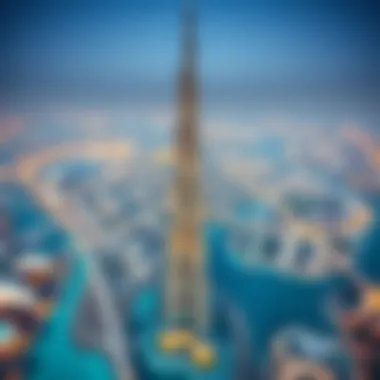
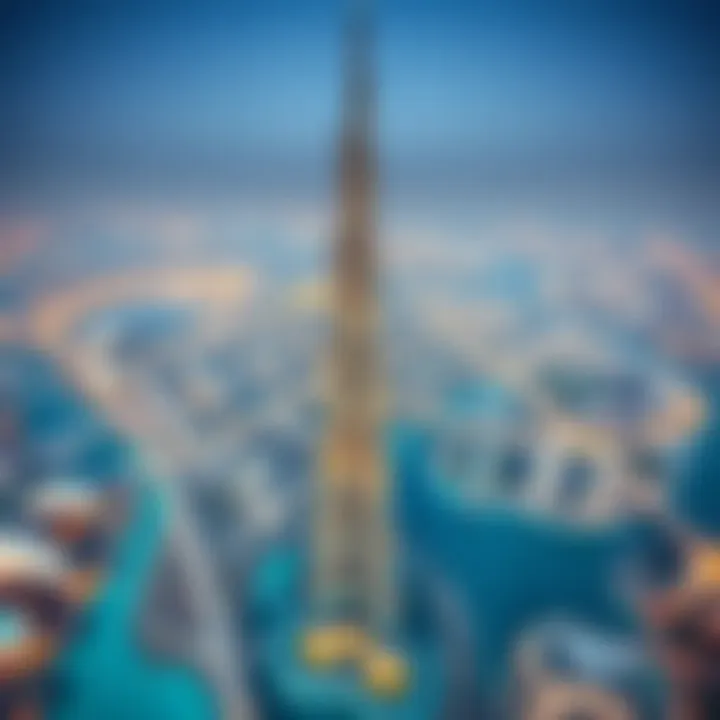
Both locals and tourists gather together at its base, soaking in the harmonious blend of culture, commerce, and innovation that the Burj Khalifa embodies. It not only stands tall physically but also forms a key piece of Dubai's identity as a global hub for tourism.
Contribution to Dubai’s Economy
The economic ramifications of the Burj Khalifa extend far beyond its ticket sales. As it facilitates tourism, it simultaneously fuels various sectors in Dubai’s economy. The ripple effect of its presence can be seen across multiple industries.
To break down its economic contributions:
- Job Creation: The Burj Khalifa directly and indirectly employs thousands, spanning various jobs from hospitality and retail to maintenance and security. This becomes vital in a city that constantly seeks to balance its economic framework.
- Increase in Real Estate Values: Properties near the Burj Khalifa have seen their values skyrocket. The demand for residential and commercial real estate in that vicinity is indicative of its positive influence on the market.
- Boosting Local Businesses: The influx of tourists stimulates business for local vendors, restaurants, and shops around the Burj Khalifa. For instance, eateries nearby report significant increases in foot traffic and revenue from hungry visitors drawn to the area post-visit.
- Global Investment: The building has positioned Dubai as an alluring spot for investors. With increasing focus on high-quality infrastructure, global powerhouses are eager to invest in real estate and ventures linked to the site.
The Burj Khalifa is more than a building; it's a beacon of economic vitality that shapes the landscape of Dubai.
In summary, the Burj Khalifa serves both as an extraordinary tourist attraction and as a vital contributor to Dubai's economic vitality. Its impact is not just felt in the immediate vicinity but resonates throughout the various facets of the city and beyond, painting a rich tapestry of opportunity, growth, and cultural exchange.
Living and Working in Burj Khalifa
Living and working in Burj Khalifa represents a unique blend of luxury and functionality, making it an attractive option for many individuals and businesses alike. This iconic skyscraper is not just a feat of engineering; it’s also a community that offers a one-of-a-kind experience. Residents and tenants often rave about the perks that come with calling this towering structure home or setting up shop within its walls.
Residential Spaces
Residential options in Burj Khalifa are defined by elegance and sophistication. The building houses 900 private residences that range from one to three bedrooms, boasting breathtaking views of the Dubai skyline and beyond. These apartments come equipped with high-end finishes and modern appliances, offering a living experience that is hard to find elsewhere.
Considerations for potential residents include not just the luxurious amenities but also access to a world-class lifestyle. Living here means being just an elevator ride away from the building’s observation decks, pools, and restaurants. It’s akin to living in a high-end resort, combined with the vibrancy of urban life.
Such exclusivity also comes with a significant price tag, making the choice an essential aspect for many home buyers who want to invest wisely. The prestige associated with residing in the tallest building in the world can’t be overlooked, as it often translates to a desirable social standing.
Commercial Opportunities
Burj Khalifa also provides ample commercial opportunities. The building features numerous office spaces that cater to a variety of businesses, from startups to global corporations. The allure of operating from one of the most recognizable landmarks presents substantial networking potential, not to mention the opportunity to attract clients and partners who are fascinated by its architectural grandeur.
Being based in such a prominent location has its advantages, including:
- Increased visibility: Companies can benefit from the building's status, which often draws attention from both locals and tourists.
- Amenities: Businesses have access to high-quality facilities, conference rooms, and communal areas which enhance productivity and collaboration.
- Transportation: Easy access to public transport and major roads makes commuting less of a headache.
"Operating from Burj Khalifa isn’t just about the office space; it’s about being part of a dynamic environment that inspires creativity and success."
The combination of impressive views and excellent services positions Burj Khalifa as a premier commercial hub. This can strategically influence business growth and employee satisfaction, leading to enhanced productivity.
Technological Innovations
The Burj Khalifa stands not just as a monument to engineering prowess but also as a testament to cutting-edge technological innovations. The adoption of advanced technologies has been pivotal in making this skyscraper the tallest building in the world. The innovations are key not only in construction but extend to sustainability, safety, and the enhanced experience for its residents and visitors. Understanding these technological advancements provides insight into what makes Burj Khalifa a paragon of contemporary architecture.
Sustainability Features
Sustainability is a cornerstone in the structure's operation and its long-term viability. The design incorporates various features aimed at minimizing environmental impact. For starters, the Burj Khalifa uses a condensing water system that recycles water from the air. This technique reduces the amount of water needed from outside sources, making efficient use of natural resources.
Moreover, the façade of the building is designed with materials that reflect sunlight, effectively managing heat gain. This clever design keeps inside temperatures regulated without excessive reliance on air conditioning, thus lowering energy costs significantly. Notably, the building also includes a state-of-the-art greywater recycling system. This system allows the facility to reuse water from sinks and showers for landscape irrigation, which is quite innovative considering the arid climate of Dubai.
"The Burj Khalifa is not just a marvel of height, it’s a model for sustainable skyscraper design."
These sustainability features position Burj Khalifa as a leader in eco-friendly architectural practices. Investors and property managers are increasingly recognizing the importance of such innovations, especially in a world where environmental consciousness is paramount. Over the years, these features are likely to enhance property values for both commercial and residential spaces in the vicinity.
Smart Building Technologies
Another layer to the technological marvel of the Burj Khalifa is the implementation of smart building technologies. The building integrates a range of automated systems designed to streamline both maintenance and user experience. One noteworthy technology is the Building Management System (BMS). This system controls and monitors all equipment in the building—from HVAC to lighting systems—ensuring optimal performance and energy efficiency.
In the realm of safety, the smart fire detection and alarm systems deployed enhance the overall safety protocols in place. These systems are capable of real-time monitoring, providing immediate alerts and guiding residents and visitors in case of emergencies. This sort of responsiveness is crucial in high-rise buildings, where evacuation can be complex.
Furthermore, Burj Khalifa employs elevator technology that vastly reduces waiting times. The double-decker elevators are particularly significant, cutting down travel times while providing access to numerous floors efficiently.
As the technology landscape continues to evolve, the relevance of these smart solutions in buildings like the Burj Khalifa cannot be overstated. In the eyes of investors and home buyers alike, the future-proofing of these properties through technological innovations offers substantial long-term benefits.
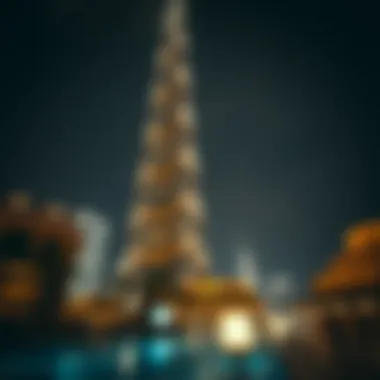
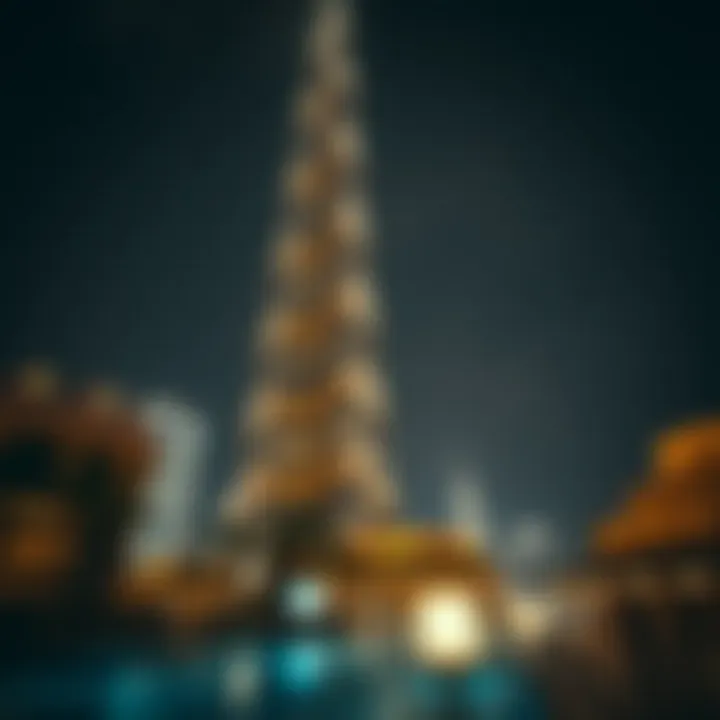
Future of Burj Khalifa
The Burj Khalifa, standing tall in the heart of Dubai, is not just a structure of immense height but a beacon of potential for the future. As the world evolves, so does the utility and significance of this architectural marvel. The future of Burj Khalifa entails more than just standing as the tallest building; it represents a dynamic environment where innovations merge with real estate opportunities. This analysis explores the implications of upcoming projects around this iconic structure and its continued significance in the real estate market.
Upcoming Projects in Proximity
Several development initiatives are underway in close proximity to the Burj Khalifa, which aim to enhance the area not just aesthetically but also economically. These projects are investments in the future, pushing boundaries and creating vibrant spaces for residents and tourists alike.
- Dubai Creek Tower: Once completed, this will rival the Burj Khalifa in height. The development aims to be a centerpiece of a new urban area along the Dubai Creek, introducing retail, hospitality, and residential spaces.
- Downtown Dubai Developments: A multitude of luxury hotels and high-end shopping arcades are planned to surround the Burj Khalifa, amplifying its stature as a tourist magnet. Future plans for improved connectivity and pedestrian-friendly zones are also on the horizon.
- Cultural District: Envisioned as a melting pot of art and culture, this area will include galleries, museums, and public art installations. This ongoing evolution points toward a future where Burj Khalifa becomes integrated into a more diverse cultural fabric.
These upcoming projects are more than just physical additions; they symbolize a commitment to sustainability and urban development, ensuring that areas around Burj Khalifa thrive and grow.
Continued Relevance in Real Estate
The Burj Khalifa is a milestone in real estate, and it continues to set precedence in various ways. Its influence on the property market in Dubai and beyond echoes, highlighting important trends for investors, developers, and city planners alike.
- Luxury Residences: The apartments nestled within the Burj Khalifa are in constant demand. They offer unparalleled views and amenities, ensuring their value doesn’t just keep pace but often exceeds market expectations.
- Commercial Spaces: Companies seeking a prestigious address often find themselves drawn to Burj Khalifa's offices, which come with branding advantages that few locations can match. The economic prospects tied to being associated with this landmark remain strong, attracting international businesses.
- Global Events Hub: The Burj Khalifa's role as a host for high-profile events continues to solidify its appeal. This not only attracts visitors but also promotes a bustling atmosphere, enhancing the surrounding property values.
In essence, the Burj Khalifa stands as a testament to successful urbanization, reflecting the aspirations and ambitions of Dubai. As the landscape around it transforms, accepting these changes ensures the Burj Khalifa remains a cornerstone of luxury and a symbol of high standards in real estate.
"The Burj Khalifa, a marvel of modern engineering, not only defines the characteristic skyline of Dubai but continues to inspire future developments that embody innovation and grandeur."
As the world keeps spinning forward, the Burj Khalifa will meet it head-on, poised to harness its towering presence and steering potential into new realms for all of its stakeholders.
Architectural Style
The architectural style of Burj Khalifa is not merely a superficial aspect; it embodies a tapestry of cultural and historical significance reflecting both its Islamic heritage and modernist innovations. Understanding this characteristic is pivotal to grasping how the structure stands not just as a feat of engineering but as a landmark that symbolizes Dubai's rapid growth and its aspirations on the global stage.
Influence of Islamic Architecture
Burj Khalifa’s design is deeply rooted in Islamic architectural principles, serving as a contemporary interpretation of traditional Islamic motifs. The way the tower reaches for the sky can be seen as an homage to the minarets of age-old mosques. The use of geometric patterns and intricate textures draws from Islamic art, blending ancient aesthetics with modern techniques.
Furthermore, the organic shape of the building is inspired by the Hymenocallis flower, a design choice that evokes the region’s native flora, while the tower’s Y-shaped floor plan helps in maximizing views of the surrounding landscape. This y-pattern is a nod to the structural approaches seen in Islamic designs where light, nature, and space are integral components.
Looking at Burj Khalifa, one can see how Islamic architecture emphasizes not only beauty but also functionality. It incorporates advanced materials such as reinforced concrete to achieve its striking height, creating a seamless fusion of traditional and cutting-edge practices. This balance is not just eye-catching; it also reflects the importance of sustainability and environmental harmony, vital considerations in contemporary building practices.
"The Burj Khalifa stands as a testament to the adaptability of Islamic architecture, demonstrating that ancient influences can coexist with modern innovations."
Postmodern Characteristics
It's also crucial to recognize the postmodern characteristics embedded in the Burj Khalifa’s design. Postmodernism, with its emphasis on pastiche and variety, can be observed in the tower's soaring form and unique silhouette. The building's tapered profile, which culminates in a spire, is a striking departure from conventional skyscraper designs, making it an icon of 21st-century architecture.
This blend of styles not only makes the building visually appealing but also aligns with the postmodern ethos of challenging norms. The tower uses a variety of materials such as glass, steel, and concrete, showcasing a technological embrace that defies traditional categorizations of architectural style.
Additionally, the mix of both aesthetic and functional properties speaks to the postmodern idea of pluralism. Unlike modernist architecture, which often focused on a single narrative, Burj Khalifa embraces multiple influences and functions cohesively, striking a harmonious chord between form and use. This adaptability is essential in attracting investors and property managers who seek versatility in urban designs as they cater to a diverse population of residents and businesses.
As such, the architectural style of Burj Khalifa is a captivating case study. It combines traditional Islamic elements with postmodern characteristics, presenting a complex identity that fosters both cultural pride and forward-thinking innovation. Understanding this architectural duality offers insights into how skyscrapers can serve as more than just real estate—they can become symbols of a community's values and aspirations.
Social Dynamics
The Burj Khalifa stands not only as a remarkable feat of engineering but also as a vibrant community hub fostering social dynamics among its occupants. This section explores how living and working within the world's tallest building contributes to a unique lifestyle that influences both personal interactions and communal activities.
Community Living
Living in Burj Khalifa is akin to residing in a lively microcosm, where the skies meet a multitude of cultures and backgrounds. The tower houses over 900 private residences that range from one-bedroom apartments to luxurious penthouses. These spaces are designed with elegance yet ensure the residents enjoy functional living. More than just a place to sleep, these homes provide a sense of ownership and belonging in a structure that epitomizes modernity.
The sense of community is amplified by shared amenities—like the pools, fitness centers, and lounges—where neighbors can cross paths and engage in casual conversations. People get to know one another not just as residents, but as part of a larger family that binds the vertical living experience. As diverse as the city of Dubai itself, the interests and backgrounds of Burj Khalifa’s residents create a melting pot of ideas and cultures.
This building has become one of those places where chance encounters can spark friendships and collaborations, which is something quite unique for a high-rise tower.
Interaction Among Residents
The interaction among residents in Burj Khalifa transcends the usual greetings one finds in typical apartment complexes. The layout encourages mobility, and the elevators even play a role, as they bring them together, setting the stage for spontaneous conversations.
Shared events and activities often promote engagement, from casual meet-ups at the observation decks to organized social gatherings in communal areas. Despite the height, the structure manages to normalize the usual social interactions that one would expect in any community.
Through these engagements, residents can form support systems that exist beyond the confines of their individual apartments, leading to long-lasting friendships and networks, which are vital in an ever-busy city like Dubai.















